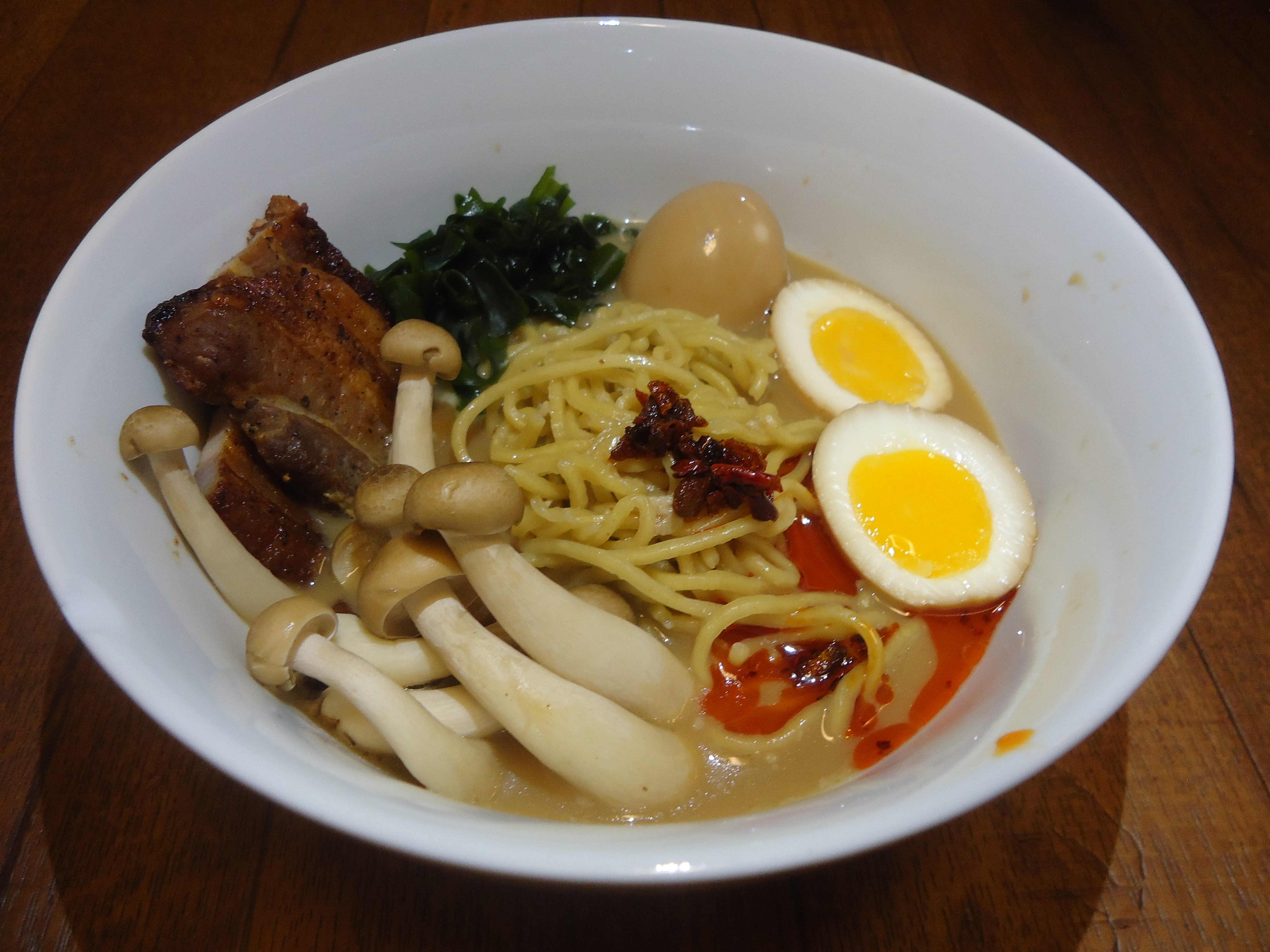I was looking forward to this one! Ramen has been a favorite of mine for a long time but I feel due to instant noodles it has a bad reputation and is seen as a poor mans food. To combat this perception, I decided to make Ramen over Sushi to represent Japan. I put a lot of pressure on myself to really represent this dish well and I decided to make everything by hand.
There were four things I needed to prepare for this Ramen to be a success.
- Tonkatsu Broth
- Pork Belly
- Ajitsuke Tamago(A marinated softboiled egg)
- Noodles
Most of the ingredients I needed could only be obtained at the Asian grocery store. I asked the butcher at my regular super market for pig trotters and she had no idea what I was talking about. I have always loved going to the Asian markets even when I was a freshman in NYC. Our dorm was right by Chinatown and I would wander over and just walk through the stacks of items that were completely foreign to me, to me it was like taking a trip to Asia.
Fortunately for me, they had everything I needed
I did however feel that I was being watched while I was at the grocery store.
The Night Before
I had planned to have a quiet night in and get everything except the noodles prepared. However I was invited out and being Friday night the temptation was overwhelming. Once I left the bar, it was time to get the Ramen started. The pork belly was the easiest so I started with that, all I had to do was add salt,sugar, and black pepper and place in the fridge overnight. This would have been much easier with slab pork belly, but the butcher counter was closed by the time I left the bar.
Next up was to prepare the Ajitsuke Tamago. I find the process of soft boiling to be an exact science much like baking. The most important step is to use a pin and pop the air cell before boiling which makes the egg much easier to peel afterwards. Once those are successfully boiled, prepare the marinade consisting of the following ingredients.
- 1 cup water
- 1 cup sake
- 1/2 cup soy sauce
- 1/2 cup mirin
- 1/2 cup sugar
Then cover with a paper towel and place in the fridge for 4-12 hours.
Preparing the broth was probably the worst thing i had to do in my Clcooks career. A tonkotsu broth is prepared with pig’s trotters(feet) and chicken bones. To get the desired milky consistency of the broth, you have to clean the bones very well after boiling. The cleaning was time consuming and the smell was awful. Doing this at 11 at night made me reevaluate some life decisions and I probably should have kept drinking while doing this to forget.
After the arduous process of cleaning the bones, they were placed in the pot.
While I was working on cleaning the bones, the mushrooms and onion were being charred to add to the flavor of the broth.
Last job of the night was to bring the pot to a simmer and clean off any fat that came to the surface. I probably spent 40 minutes just cleaning the broth alone.
The Next Day
When I woke up the next morning, my whole apartment smelled like pork. I had to get up and open the windows because the smell was omnipresent. The broth was bubbling along on the stove. I brought the temperature down to a simmer and covered the pot. During the day, I would check in and refill the pot with water as needed. The broth isn’t as milky white as I was hoping but it was close enough for me.
While the broth was simmering, it was time to prepare the pork belly. All that needs to be done was place the seasoned pieces of pork belly on a pan with a drip tray and throw in the oven at 450 degrees for 30 minutes. I ended up burning my arm really bad pulling these out of the oven as the fat sloshed over and hit my arm. Don’t let it happen to you.
The broth continued to cook all day. When I was satisfied that it had an appearance close to Tonkotsu, I added some pork fat to the broth. This would have been nicer with a slab of pork fat like the recipe calls for, the individual fat pieces were easy to remove.
The final thing to make was the noodles. The dough as mentioned in the recipe is incredible tough to knead and I thought the KitchenAid mixer was going to blow up at times.
The dough was very crumbly and it took a couple tries to get the right result when rolling through the pasta maker. It felt like a never ending cycle of flour and water to finally get it to work right.
Finally some nice noodles to work with!
The final step was to cook the noodles, and add the broth and toppings. The noodles looked amazing after they were cooked, they tasted great too!
The softboiled eggs absorbed the color of the marinade.
The final result all together, along with some Lao Gan Ma Spicy Chili Crisp sauce and some seaweed. The Spicy chili crisp sauce is so good and I have been using it on everything, you need to consider it mandatory to add to the Ramen. You can find it on Amazon here.. The seaweed was particularly cool as it came dehydrated which makes it easy to use.
The Ramen was delicious, the broth especially had a heartiness that was not too heavy. The eggs were wonderful but truthfully did not have the same flavor as the one’s I get at the local store. The marinade was too sweet and probably could have used less sugar. As for the meat, the pork belly was amazing, seriously I could just eat that. Homemade noodles have a delightful springiness to them that is hard to describe, they are always worth the effort. I made a small mistake adding some of the marinade to the Ramen, which made the Ramen broth a little too sweet but it was still good.
You would smile too, if you just finished cooking after 24 hours!
If I was going to advise people I would make the pork belly and the noodles from the recipe below. I don’t believe I would attempt a tonkotsu broth again and I felt the eggs were good but not quite right. When I decide to prepare a Ramen from scratch again, I would would do a chicken style base broth instead like this recipe outlines and use this recipe for the Ajitsuke Tamago.
The recipes I used are listed below.














